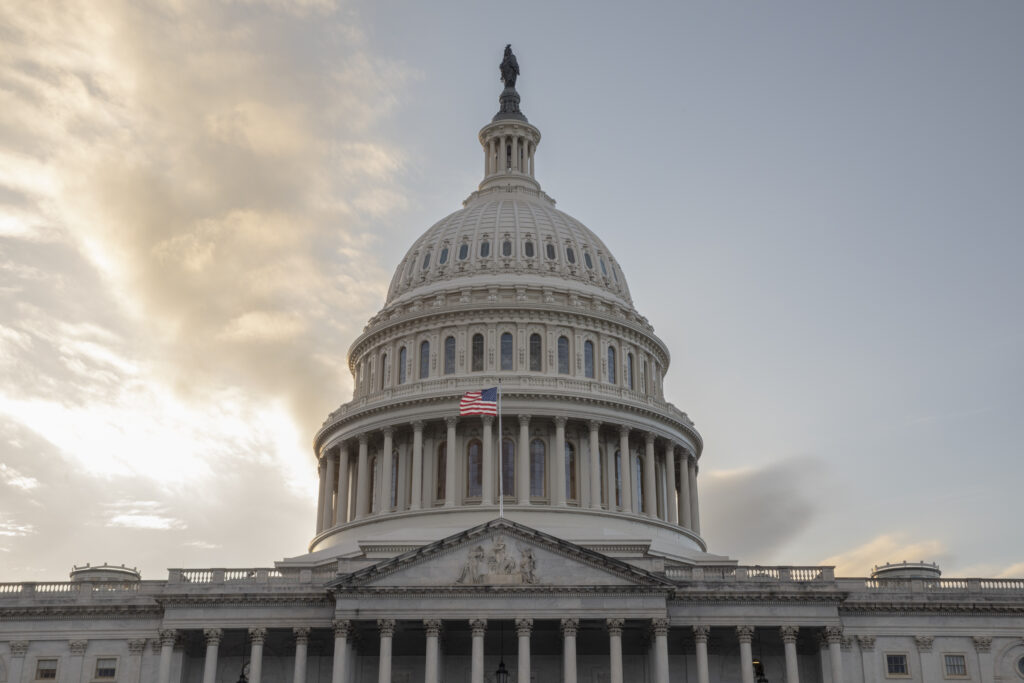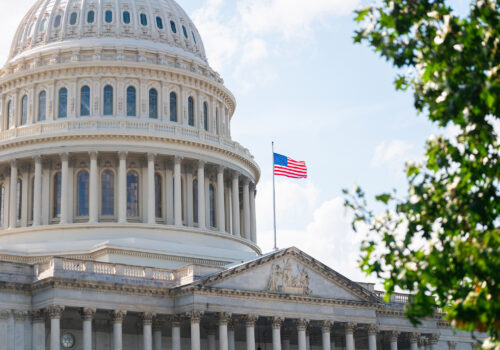The US Congress may soon adopt legislation to regulate stablecoins—digital tokens pegged to the US dollar. Although used today primarily to trade other crypto assets, stablecoins could become a widely used payment instrument, which would drive valuable innovation and competition. David Sacks, the Trump administration’s crypto “czar,” has predicted that stablecoins could also “ensure American dollar dominance internationally” and generate “trillions of dollars of demand for US Treasuries.” Stablecoin critics, in contrast, argue that legislation would legitimize a product that is widely used for money laundering and sanctions evasion while fueling crypto speculation and scams.
We have each advised or chaired executive branch agencies involved in digital asset policy and co-authored articles about why and how to regulate stablecoins. One of us testified before Congress in February about the pending legislation. We share concerns about the illicit use of stablecoins and the speculative nature of much of the crypto market. But stablecoin legislation is likely to be enacted this year: the Trump administration prioritized the issue in its digital assets executive order three days after the inauguration; Republican leaders in the Senate and House, together with Sacks, promised to pass stablecoin legislation within the administration’s first one hundred days; and bills have been passed out of both House and Senate committees. Therefore, the focus now should be on how best to regulate stablecoins, not whether to do so.
Stablecoins, moreover, already exist—the market capitalization is now over $230 billion and growing rapidly, almost all in dollar-pegged stablecoins. If the United States does not create a credible regulatory framework, the risks associated with stablecoins will only increase. In addition, the United States will lose the ability to set standards for liabilities denominated in its own currency because other jurisdictions are rapidly creating frameworks that permit dollar-based stablecoins.
The two bills under active consideration in Congress—the GENIUS Act in the Senate and the STABLE Act in the House—create some helpful guardrails to ensure that stablecoins are indeed stable. But the bills also contain significant flaws. Here are six ways that the bills must be improved to establish an effective stablecoin regulatory regime.
1. Close the foreign issuer loophole
The biggest weakness in both bills is that they do not adequately regulate offshore stablecoin issuers. This means they both fail to regulate Tether, the largest issuer of dollar-pegged stablecoins. This foreign issuer loophole, or “Tether loophole,” completely undermines the purpose of US stablecoin legislation.
Both bills require a company that “issues” stablecoins in the United States to be licensed and supervised by a federal or state regulator and comply with a host of prudential requirements. These include ensuring that tokens are fully backed by high-quality reserves and meet capital and other risk management requirements; they also limit issuers’ activities. But if the stablecoins are issued offshore and simply flow back into the country, the GENIUS Act imposes no restrictions on the issuer or on the use of those stablecoins as long as the issuer is able to “seize, freeze, burn or prevent the transfer of” tokens at the direction of law enforcement. These are powers that most stablecoin issuers already wield.
The foreign issuer loophole in the GENIUS Act puts US stablecoin issuers at a serious regulatory disadvantage, as they will be required to operate under prudential and supervisory requirements that won’t apply to many foreign-issued stablecoins. Indeed, it incentivizes new issuers to incorporate offshore and existing domestic issuers to relocate to jurisdictions with more attractive, less effective regulatory frameworks. Consumers will also face confusing choices, as US prudential standards, bankruptcy provisions, and other consumer protections will apply to some payment stablecoins circulating in the United States but not others.
The STABLE Act provides an eighteen-month grace period after which an offshore issuer must be “subject to” a supervisory regime in another country that is deemed comparable to the US regime, or else its stablecoins cannot be offered or sold by “a custodial intermediary.” But this approach, too, is inadequate. The bill does not impose a prohibition on the use of stablecoins that are offered and sold without the involvement of a custodial intermediary. What’s more, the STABLE Act does not have a clear enforcement mechanism applicable to foreign stablecoins, suffers from material drafting ambiguities that could cause legal uncertainty, and envisions insufficient penalties for noncompliance.
Legislation that encourages stablecoin issuers to incorporate abroad undermines the goals the administration laid out in its executive order on digital assets, including promoting US leadership in financial technology and protecting the dollar. Moreover, if the stablecoin market continues to grow at anything near its current pace, the scale of dollar-denominated liabilities created offshore could become systemically important, as was the case with Eurodollars. While those offshore dollar deposits started off small, by the early 2000s, they had exceeded the total deposits held by banks in the United States. The US government will ultimately have to reckon with a large offshore stablecoin market, as it had to reckon with Eurodollars.
A better approach can be found in proposed bipartisan stablecoin legislation negotiated last year by Representative Patrick McHenry, then chairman of the House Financial Services Committee, and Representative Maxine Waters, the ranking member. The McHenry-Waters bill—which was not taken up before the last Congress ended and has been reintroduced by Waters this year—would make it illegal to “engage in the business of issuing a payment stablecoin, directly or indirectly in the United States through any means or instrument of transportation or communication in the United States, or by persons in the United States.” In addition, it would impose stiff civil and criminal penalties on those who offer or sell any unlicensed stablecoin in the United States or to any US person.
Replacing the foreign issuer loophole with a strong extraterritorial provision could still be coupled with provisions under which a foreign issuer, in lieu of registering in the United States, can be licensed and supervised by a jurisdiction that Washington deems to have equivalent rules. But any such “substituted compliance” arrangement should be at least as robust as what is already in place for globally systemically important banks and derivatives clearinghouses—including, for example, joint supervisory arrangements between the United States and foreign regulators for large issuers.
2. Enhance the Treasury Department’s authority to prevent illicit finance
One strength of the GENIUS Act relative to the STABLE Act is that it requires issuers to implement a variety of measures to prevent illicit activity, including the ability to freeze and seize stablecoins at the request of law enforcement (although the latter is not a substitute for jurisdiction over foreign issuers, as noted above). But a more comprehensive approach is needed because stablecoins can be transferred on decentralized blockchains without any involvement by the issuer. The legislation should provide the Treasury Department with broad authority to address illicit finance concerns. This should include the authority to issue blocking orders with respect to on-chain protocols—such as mixers, tumblers, and other arrangements—that malevolent actors can use to disguise illicit transactions or sanctions evasion and thwart law enforcement efforts. Congress should also provide the Treasury Department’s Office of Foreign Assets Control with the same jurisdiction and authority over US dollar stablecoin transactions that it already has over other dollar-denominated transactions.
3. Balance state and federal authority
Both bills provide for dual state and federal paths for the chartering, regulation, and supervision of a stablecoin issuer. The STABLE Act requires that a state’s regulatory standards must meet or exceed the federal standards, whereas the GENIUS Act has a weaker “substantially similar” standard. However, the STABLE Act does not provide for adequate joint federal-state supervision of large issuers, thus creating the risk that a systemically important issuer could be supervised only by state authorities. By contrast, the GENIUS Act appears to require joint supervision of issuers with a market capitalization in excess of ten billion dollars (although the drafting is unclear on several critical issues). The strengths of each bill should be combined in the final legislation.
4. Limit the activities of affiliates of stablecoin issuers
Both bills include relatively tight activity restrictions on stablecoin issuers, but neither imposes any group-level activity or affiliation restrictions. Stablecoin issuers that are subsidiaries of insured depository institutions would presumably still be subject to restrictions under the Bank Holding Company Act (BHCA). However, the affiliates of nonbank stablecoin issuers would be free to carry on other types of business activities, as well as to lend money to, and borrow money from, any affiliated stablecoin issuers. Group or affiliate restrictions help prevent financial distress in a related entity from spreading to the stablecoin issuer and jeopardizing its commitment to maintain a stable nominal value for its stablecoins.
In addition, unlike bank regulation under the BHCA, the absence of such restrictions on nonbank issuers would provide an unobstructed path for large technology platforms to directly enter the market for money and payments—and thereby exploit their enormous network effects, privileged access to customer information, and other comparative advantages to further concentrate and entrench their already significant market power. In contrast, the McHenry-Waters bill combined tight activity restrictions on stablecoin issuers with corresponding group-level activity and affiliation constraints, which should be included in stablecoin legislation going forward.
5. Make a specialized procedure for stablecoin issuer bankruptcy protections
Another area in which the two bills need improvement is bankruptcy protections. As we have noted elsewhere, a specialized resolution procedure for insolvent stablecoin issuers, similar to what the United States has for banks, would be preferable to applying standard Chapter 11 procedures for stablecoin issuers. That would ensure that token holders get repaid quickly and in full, whereas Chapter 11 could force holders to wait until the end of an uncertain, lengthy, and costly process and face a risk of getting back only a fraction of what they are owed. A specialized procedure would also minimize the risk that an issuer’s failure leads to further runs or more widespread contagion. While the McHenry-Waters bill contemplated such a specialized regime, neither bill pending now in Congress takes this approach. Rather, they include provisions designed to improve how stablecoin issuers would be resolved in Chapter 11 bankruptcy.
The GENIUS Act provides a slightly better set of bankruptcy protections than the STABLE Act—including carving stablecoin reserves out from an issuer’s bankruptcy estate, giving holders priority over other claims, creating a procedural right for lifting the automatic stay, and returning reserves to holders. But these protections should be strengthened. First, the applicable regulator should be able to lift the automatic stay and restrict an issuer’s ability to pledge reserves (which could undermine recovery by the holders and thus spark potential destabilizing runs). Second, because most holders acquire stablecoins in the secondary market and not directly from the issuer, the legislation should make clear that all holders have a claim in bankruptcy.
6. Strengthen consumer protections
Both pending bills are relatively light on consumer protections. Ideally, they should contain some protections relating to the disclosure of terms, settlement procedures, fraudulent and unauthorized transfers, and dispute resolution, rather than leaving those issues to private ordering. But at minimum, there are two areas in which changes to the GENIUS Act introduced just prior to the committee vote made it inferior to the STABLE Act and should be reversed. First, the application of consumer privacy protections under the Gramm-Leach-Bliley Act to stablecoin issuers was deleted. This should be reinstituted, and ideally, privacy protections should be strengthened beyond what is required under that law. The second change to the GENIUS Act concerns custodial arrangements for reserves and stablecoins. Both bills require custodians to meet traditional standards imposed in securities law and other areas, but the GENIUS Act was amended to require those standards only for custody of stablecoins pledged as collateral, not for stablecoins generally as in the STABLE Act. This, too, should be reversed.
***
Beyond the weaknesses we have noted, the stablecoin bills are also a missed opportunity to modernize the US payment system by creating a technologically neutral federal regulatory framework and expanding access to Federal Reserve master accounts and other core payment infrastructure. The bills also do not address the use of stablecoins by crypto intermediaries or the broader challenges of regulating the crypto market—issues that congressional leaders say they will take up next. While we would ideally like to see all of these and other issues addressed, given the politics of the moment, some version of the pending stablecoin legislation will likely be passed soon. It is therefore vital to make the legislation as strong as it can be. The risks of an unregulated stablecoin market are growing each day. Legislation that helps safeguard consumers and markets from some of these risks is better than no stablecoin legislation at all.
Timothy Massad is a research fellow and director of the Digital Assets Policy Project at the Kennedy School of Government at Harvard University and a former chairman of the Commodity Futures Trading Commission and assistant secretary of for financial stability at the Treasury Department.
Howell E. Jackson is the James S. Reid, Jr., professor of law at Harvard Law School and served as a senior adviser on digital asset policy for the National Economic Council during the Biden administration.
Dan Awrey is the Beth and Marc Berg professor of law at Cornell Law School and a senior adviser (detailee) with the US Treasury Department.
Further reading
Wed, Feb 12, 2025
Central bank digital currencies versus stablecoins: Divergent EU and US perspectives
Econographics By Barbara C. Matthews, Hung Tran
All policymakers agree on one point: both CBDCs and stablecoins will significantly impact the global role of the US dollar.
Thu, Jan 23, 2025
What is next for crypto regulation in the US?
Econographics By Ananya Kumar
What does success on the regulatory front actually look like? What does it mean for the rest of the world? We dive into the dozen bills under consideration in Congress and zoom in on the three big themes for crypto regulation in 2025.
Thu, Jan 25, 2024
The Fed is falling behind as other central banks leap ahead on digital currencies
New Atlanticist By Josh Lipsky, Ananya Kumar
And the innovation gap is not just on CBDCs. FedNow, the long-awaited interbank settlement system, has taken years longer than comparable systems in Europe.
Image: A view of the US Capitol in Washington, DC, United States, on November 7, 2024, days after the national election. The United States Capitol, often called the Capitol or the Capitol Building, serves as the seat of the United States Congress, the legislative branch of the federal government. It is located on Capitol Hill at the eastern end of the National Mall in Washington, D.C. Photo by Aashish Kiphayet/NurPhoto.




